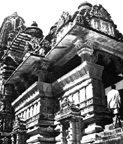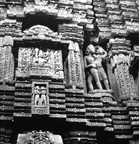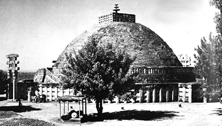


The Indian subcontinent is the site of a civilization as ancient as any in the world. City states arose in North India, along the Indus River, at about the same time as the early civilizations of the Tigris-Euphrates at Sumer and other locations. Over the centuries, India was invaded by many different peoples, all of whom left their imprint.
Hinduism developed out of a multiplicity of local gods, goddesses, and heroes. Gradually this multiplicity was given a coherent framework, in which the individual deities were seen as manifestations of a greater unity. Nonetheless, multiplicity remained a major feature of Hinduism, as it is of Indian culture in general.
Local deities were identified with cyclical forces of nature, as is common in an agricultural society-- birth, death, planting; and with the fertility of land, herds, and human beings.
Gradually the belief arose that all these gods were manifestation of the One- Brahma. The physical world in all its variety was seen as a dream of Brahma; it comes into existence, ends, and is reborn in great cycles, as are human souls in the shorter cycles of human lifetimes. This cyclical idea, which reflects the cycles of seasons and fertility, repeats endlessly. The human soul, which is eternal, is reborn, or reincarnated. The actions of the individual in this life accumulate as karma, which affects the status one will achieve in the next life. The ultimate goal is maksha, or the achievement of spiritual perfection which will enable the soul to achieve release from the wheel of life, and attain oneness with Brahma. This link will take you to more information about Hindu religion and culture.

The idea of caste is closely associated with Hindu beliefs about spiritual progress through the accumulation of karma and reincarnation. Caste is the division of society into rigid classes, which define one's status, occupation, and relationships. Historians believe that the caste system was introduced into India at the time of the Aryan invasions, c. 1500 B.C. as a means of separating the conquerors from the conquered. In due course, this stratification of society was sanctioned by Hinduism, in which caste came to be associated with the level of spiritual attainment.
Thus in India we find a multiplicity of ethnic groups-- hundreds of separate languages are spoken-- a multiplicity of castes within each community-- and the worship of a multiplicity of gods that vary according to locality, caste, and personal preference.
In this context, there are many paths to salvation, but one goal: to achieve release from the wheel of rebirth, to leave this world which is believed to be an illusion. The essential duty of the good Hindu can be summarized as follows:
Although there are many local deities, there are certain deities that are believed to be preeminent, and are widely recognized. Four in particular are of major importance:
Brahma-- the creator
Vishnu-- the preserver
Shiva-- the destroyer
Kali/Durga/Parvati-- the goddess in three incarnations: death and destruction,
maiden, and mother.
The sacred writings of Hinduism - the Baghvad Gita, the Ramayana, and others, are a mixture of mystical writings and allegorical interpretations of history. Many of the figures and events are believed to reflect actual events and individuals in ancient Indian history.
Both Buddhism and Islam were also important in the culture of the Indian subcontinent. Buddhism first arose in India in the sixth century B.C, but became more important outside of India than within it. Islam came to Northern India (now Pakistan) beginning in the eighth century AD. Since these religions were also of importance in other regions, they will be discussed elsewhere.

The sacred quality of all aspects of life is reflected in Indian art, as is the multiplicity of spiritual and cultural experience. Since the sacred is incarnate in all living things, animal or part-animal images are commonly used to represent gods; plant forms as well become important religious symbols. The cyclical basis of Indian cosmology reflects the cycles that rule in an agricultural culture, as well as the fertility cycles of human and animal reproduction, and this is often symbolized through the use of wheels and circles used to organize or emphasize compositions. This link will take you to a further commentary and examples of Hindu religious art

As in most traditional cultures, visual symbols are a powerful means of relaying religious and social ideals, as well as history. Since much of the population was illiterate, visual images developed to serve as an aid to memory for orally transmitted literature and history. This use of visual aids to memory and the transmission of culture is common to all traditional, preliterate cultures. Among the most impressive examples are the intricate carvings that cover the surfaces of Hindu temples. Temple architecture in India tends to be filled with carvings of gods, heroes, and the tales of their lives, all well known to those who are immersed in the cultural traditions. The effect is again one of multiplicity unified by a visual style that reflects and expresses the life and history of India itself.
This link will take you to examples of Indian painting.

Buddhism first arose in India in the 6th c. BC as an alternative to Hinduism. It was accepted By King Asoka in the 3rd c. BC, and enjoyed a period of preeminence during the following centuries. Buddhist monuments and shrines are to be found in many parts of India. Among the most important are the stupas. A stupa is a monument which either shelters a sacred relic, or marks the site of an important event in the life of a Buddhist saint. The oldest of the stupas dates to the 3rd century BC, built by King Asoka. Another important Buddhist monument is the shrine of the Ajanta caves, a complex that dates back to 150 AD. However, Buddhism was to have its most lasting impact outside of India; therefore we will discuss the nature of Buddhism elsewhere. Early Buddhist art in India relies on the imagery and aesthetics of earlier Hindu traditions. The poses, gestures, and accompanying figures, plants, and animals seen in representations of Buddha and buddhist saints (bodisatvas) draw on Hindu images. The first use of a halo anywhere in the world to denote a holy figure is purported to have been in an Indian carving of Buddha dating from the first century.

Islamic art in India includes fine examples of painting and architecture; the best known example is the Taj Mahal , a tomb built for Mumtaz Mahal, the wife of the Mogul emperor, Shah Jehan. Islamic style in India shares many features with the Islamic traditions of Persia, which are discussed elsewhere.

|